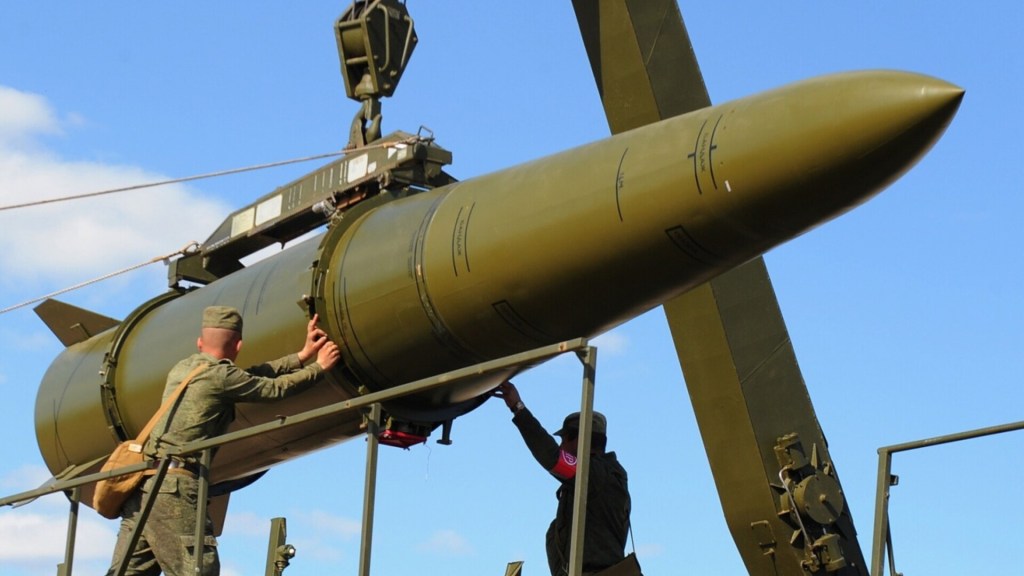Video has emerged of what may be the first M270 Multiple Launch Rocket System (MLRS) destroyed by Russia. The M270s, which can fire 227mm artillery rockets, as well as Army Tactical Missile System (ATACMS) short-range ballistic missiles, have been a bane to Moscow’s war efforts. Most recently, they were reportedly involved in a deadly ATACMS strike on Crimea earlier this week.
The 69-second video, posted by the Russian The_Wrong_Side Telegram channel on Friday, showed a drone view of the M270 pulling out of a tree line then heading down a road. The drone followed the vehicle as it entered a building located in Shevchkove, a small village in Mikoliav Oblast about 40 miles north of the frontlines.
After cutting to a wider view, the video then showed what was claimed to be an Iskander-M short-range ballistic missile striking the building. A huge ball of flames erupted as a result.

A superimposed arrow purportedly points to the burning M270, where nearby secondary explosions can be seen.

The War Zone cannot independently verify the claim that the M270 was destroyed. However, the conflagration caused by the missile certainly seems powerful enough to have ruined whatever was inside the building, which appeared to have been a forward arming and refueling facility. Stored weapons and fuel would certainly add to the intensity of any explosion resulting from such a strike.
“The footage shows the result of another successful work of Russian intelligence officers,” The_Wrong_Side bragged on Telegram Friday. “For unknown reasons, the equipment did not carry out launches (probably a technical malfunction occurred), after which it was tracked to its home base.”
“According to the already established tradition, the Iskander sent its greetings to Western equipment, completely destroying it, the escort vehicle, as well as at least 25 Ukrainian Armed Forces specialists working in the hangar,” The_Wrong_Side claimed, which we also cannot verify.
Iskander-M short-range ballistic missiles are among Russia’s most valuable precision-guided standoff weapons. They are now being used for fast-reaction strikes for exactly these kinds of time-sensitive targets. It’s really the only major precision strike munition Russia has capable of reliably hitting these kinds of high-value targets on very short notice as the Russian Air Forces has not achieved air superiority. We have seen repeated examples, for instance, of air defense systems found by Russian drones behind the front lines that are then struck by an Iskander-M.

There have yet to be any M270 losses recorded by the Oyrx open-source tracking group, however, they only tabulate things they can verify visually so it is possible that this was not the first.
These vehicles have proven valuable on the battlefield because they can achieve devastating long-range effects. They are also highly mobile, enabling crews to fire, quickly move away to hide, and return to the battlefield rearmed. A large building like the one seen in the video would be an ideal location, close enough to the front to put GMLRS in range of targets but also away from Russian FPV drones and artillery, for such clandestine activities.
The M270s feature a launch system mounted on a tracked chassis derived from the Bradley Fighting Vehicle. Like its wheeled cousin the M142 High Mobility Artillery Rocket Systems, or HIMARS, it can fire several different munitions. The aforementioned ATACMS can hit targets either 100 or 186 miles away depending on the variant. Guided Multiple Launch Rocket Systems (GMLRS) rockets can strike up to about 50 miles away. It can also fired shorter-range unguided rockets.
A single M270 can be loaded with two of the standard ammunition pods at a time, allowing it to fire up to 12 rockets or two ATACMS missiles before needing to be reloaded.
Ukraine has received several of these weapons. U.S.-made M270s have been turned over to Ukraine by both the United Kingdom and Norway. The German government has provided five MARS II systems, a country-specific derivative of the M270. France has donated at least a half dozen LRU (Lance-Roquette Unitaire) MLRS, a French version of the M270.

The loss of one M270 is a blow to Ukraine. It is likely that GMLRS rockets were stored there and even possibly some of Ukraine’s limited supply of ATACMS, as well.
The video also points to another issue. That a drone could loiter unmolested for so long over such a key piece of equipment and especially a rearming/storage, shows the challenge that Ukraine faces when it comes to air defenses. The drone operating so far from the front lines would have required a relay or a large mast to keep in contact with its controller.
Stil, Kyiv’s forces have so far been very fortunate when it comes to these donated MLRSs.
According to information compiled by Oryx, there has only been one HIMARS destroyed and two HIMARS damaged. However, as we noted previously, that figure could be higher. You can read about repair efforts for one damaged HIMARS in our story here.
Regardless, some equipment is bound to be lost in such a fierce conflict, even highly valued ones like M270s. Considering how big of a menace these vehicles have been to Russian forces, it’s impressive that so many have been able to survive for so long, especially as drone operations have expanded significantly beyond the front lines.
Contact the author: [email protected]





